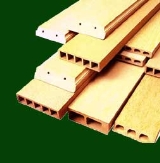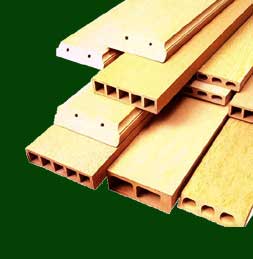
Fiber reinforced composite
Encyclopedia
A fiber-reinforced composite (FRC) consists of three components: (i) the fibers as the discontinuous or dispersed phase, (ii) the matrix as the continuous phase, and (iii) the fine interphase region, also known as the interface. This is a type of advanced composite group, which makes use of rice husk, rice hull, and plastic as ingredients. This technology involves a method of refining, blending, and compounding natural fibers from cellulosic waste streams to form a high-strength fiber composite material in a polymer matrix. The designated waste or base raw materials used in this instance are those of waste thermoplastics and various categories of cellulosic waste including rice husk and saw dust.
 FRC is high-performance fiber composite achieved and made possible by cross-linking cellulosic fiber molecules with resins in the FRC material matrix through a proprietary molecular re-engineering process, yielding a product of exceptional structural properties.
FRC is high-performance fiber composite achieved and made possible by cross-linking cellulosic fiber molecules with resins in the FRC material matrix through a proprietary molecular re-engineering process, yielding a product of exceptional structural properties.
Through this feat of molecular re-engineering selected physical and structural properties of wood are successfully cloned and vested in the FRC product, in addition to other critical attributes to yield performance properties superior to contemporary wood.
This material, unlike other composites, can be recycled up to 20 times, allowing scrap FRC to be reused again and again.
The failure mechanisms in FRC materials include delamination
, intralaminar matrix cracking, longitudinal matrix splitting, fiber/matrix debonding, fiber pull-out, and fiber fracture .
Difference between wood plastic composite and fiber-reinforced composite:

Through this feat of molecular re-engineering selected physical and structural properties of wood are successfully cloned and vested in the FRC product, in addition to other critical attributes to yield performance properties superior to contemporary wood.
This material, unlike other composites, can be recycled up to 20 times, allowing scrap FRC to be reused again and again.
The failure mechanisms in FRC materials include delamination
Delamination
Delamination is a mode of failure for composite materials. Modes of failure are also known as 'failure mechanisms'. In laminated materials, repeated cyclic stresses, impact, and so on can cause layers to separate, forming a mica-like structure of separate layers, with significant loss of mechanical...
, intralaminar matrix cracking, longitudinal matrix splitting, fiber/matrix debonding, fiber pull-out, and fiber fracture .
Difference between wood plastic composite and fiber-reinforced composite:
| Features | Plastic lumber Plastic lumber Plastic lumber is a 100% recyclable material lumber or timber made of recycled plastic. Its most widespread use is in outdoor deck floors, but it is also used for railings, fences, landscaping timbers, cladding and siding, park benches, molding and trim, window and door frames, and indoor furniture... |
Wood plastic composite | FRC | Wood Wood Wood is a hard, fibrous tissue found in many trees. It has been used for hundreds of thousands of years for both fuel and as a construction material. It is an organic material, a natural composite of cellulose fibers embedded in a matrix of lignin which resists compression... |
|---|---|---|---|---|
| Recyclable | ||||
| House Construction | ||||
| Water Absorption | 0.00% | 0.8% and above | 0.3% and below | 10% and above |
Properties
| Tensile Strength | ASTM D 638 | 15.9 MPa |
| Flexural Strength | ASTM D 790 | 280 MPa |
| Flexural Modulus | ASTM D 790 | 1582 MPa |
| Failure Load | ASTM D 1761 | 1.5 KN - 20.8 KN |
| Compressive Strength | 20.7MPa | |
| Heat Reversion | BS EN 743 : 1995 | 0.45% |
| Water Absorption | ASTM D 570 | 0.34% |
| Termite Resistant | FRIM Test Method | 3.6 |
Application
There are also applications in the market, which utilize only waste materials. Its most widespread use is in outdoor deck floors, but it is also used for railings, fences, landscaping timbers, cladding and siding, park benches, molding and trim, window and door frames, and indoor furniture. See for example the work of Waste for Life, which collaborates with garbage scavenging cooperatives to create fiber-reinforced building materials and domestic problems from the waste their members collect: Homepage of Waste for LifeSee also
- Fracture mechanicsFracture mechanicsFracture mechanics is the field of mechanics concerned with the study of the propagation of cracks in materials. It uses methods of analytical solid mechanics to calculate the driving force on a crack and those of experimental solid mechanics to characterize the material's resistance to fracture.In...
- Plastic lumberPlastic lumberPlastic lumber is a 100% recyclable material lumber or timber made of recycled plastic. Its most widespread use is in outdoor deck floors, but it is also used for railings, fences, landscaping timbers, cladding and siding, park benches, molding and trim, window and door frames, and indoor furniture...
- Wood plastic composite
- Fibre-reinforced plasticFibre-reinforced plasticFibre-reinforced plastic is a composite material made of a polymer matrix reinforced with fibres. The fibres are usually fibreglass, carbon, or aramid, while the polymer is usually an epoxy, vinylester or polyester thermosetting plastic...

